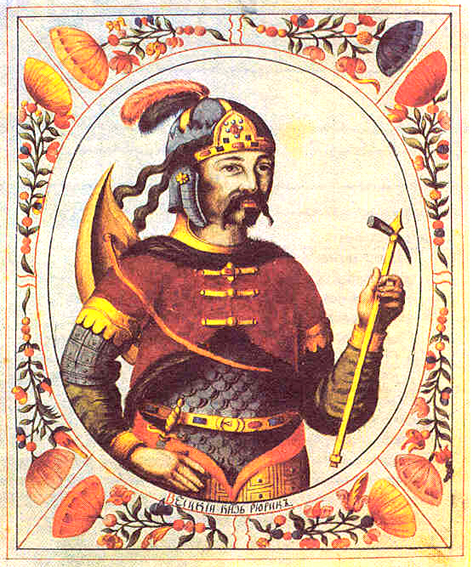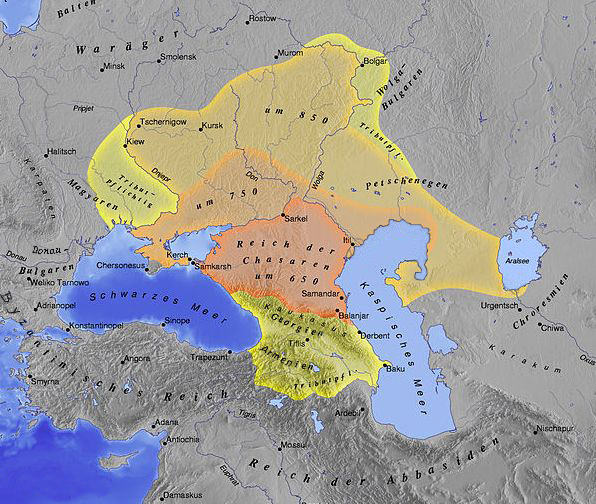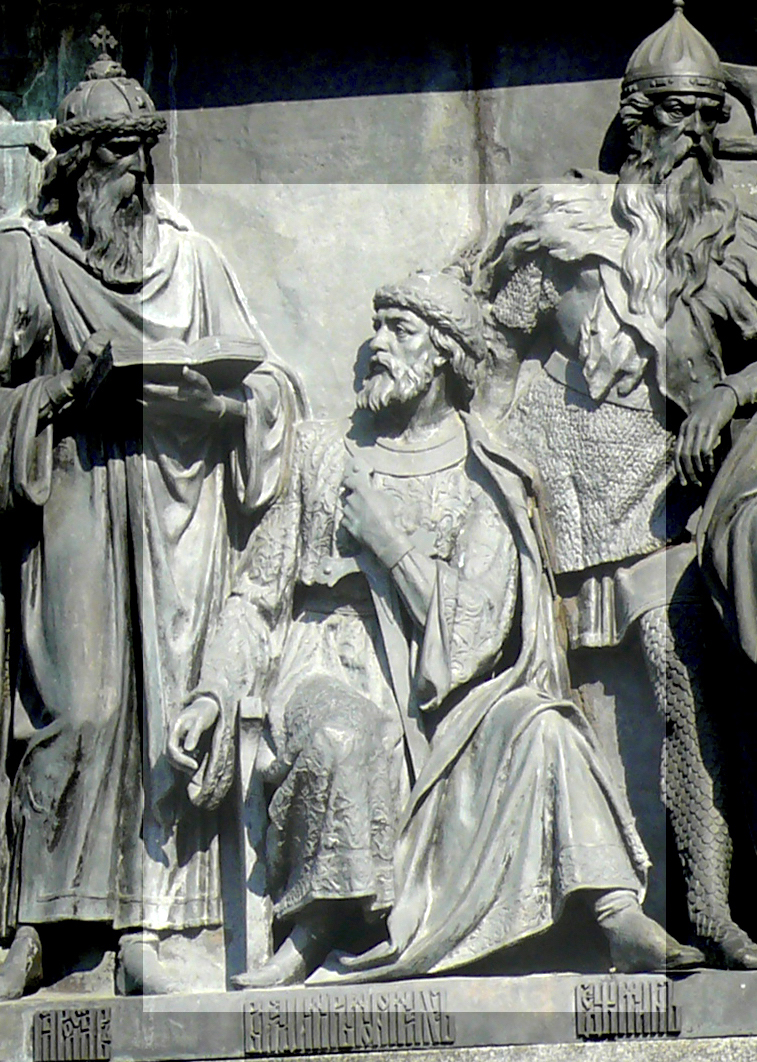|
Vladimir Of Novgorod
Vladimir Yaroslavich (; ; 1020 – October 4, 1052) was Prince of Novgorod from 1036 until his death in 1052. He was the eldest son of Yaroslav I the Wise by Ingegerd Olofsdotter, a daughter of Olof Skötkonung, the king of Sweden. He is venerated as a saint in the Eastern Orthodox Church, with his feast being on 4 October. Life In state affairs, he was assisted by the voivode Vyshata and the bishop Luka Zhidiata. In 1042, Vladimir may have been in conflict with Finns, according to some interpretations even making a military campaign in Finland. In the next year he led the Russian armies against the Byzantine emperor Constantine IX. He predeceased his father by two years and was buried by him in St Sophia Cathedral he had built in Novgorod. His sarcophagus is in a niche on the south side of the main body of the cathedral overlooking the Martirievskii Porch. He is depicted in an early twentieth-century fresco above the sarcophagus and on a new effigial icon on top of the sarc ... [...More Info...] [...Related Items...] OR: [Wikipedia] [Google] [Baidu] [Amazon] |
Prince Of Novgorod
The Prince of Novgorod () was the title of the ruler of Veliky Novgorod, Novgorod in present-day Russia. From 1136, it was the title of the figurehead leader of the Novgorod Republic. The position was originally an appointed one until the late 11th or early 12th century, then became something of an elective one until the early 14th century, after which the grand prince of Vladimir (who was almost always the prince of Moscow) was almost invariably the prince of Novgorod as well. The title originates sometime in the 9th century when, according to tradition, the Varangian chieftain Rurik and his brothers were invited to rule over the East Slavs, East Slavic and Finnic peoples, Finnic tribes of northwest Russia, but reliable information about it dates only to the late 10th century when Vladimir the Great, Vladimir, the youngest son of Sviatoslav I, was made the prince of Novgorod. During the reign of Ivan III of Russia, Ivan III, the title was restored and Novgorod was include ... [...More Info...] [...Related Items...] OR: [Wikipedia] [Google] [Baidu] [Amazon] |
Archbishop Of Novgorod
The Diocese of Novgorod () is one of the oldest offices in the Russian Orthodox Church. The medieval archbishops of Novgorod were among the most important figures in medieval Russian history and culture and their successors (as bishops, archbishops, or metropolitans) have continued to play significant roles in Russian history up to the present day. They patronized a significant number of churches in and around the city, (several of which can still be seen today), and their artistic and architectural embellishments influenced later Russian art and architecture; they also patronized chronicle-writing, a crucial source on medieval Russian history. The Republican period The office of bishop of Novgorod was created around the time of the Christianization of Rus' (988), although the chronicles give conflicting dates for its establishment ranging anywhere from 989 to 992. The first bishop, Joachim of Korsun (ca. 989-1030), built the first (wooden) Cathedral of Holy Wisdom (also cal ... [...More Info...] [...Related Items...] OR: [Wikipedia] [Google] [Baidu] [Amazon] |
Princess Consort
Princess consort is an official title or an informal designation that is normally accorded to the wife of a sovereign prince. The title may be used for the wife of a king if the more usual designation of queen consort is not used. More informally, it may even be used to describe the family position of any woman who marries royalty non-morganatically, if the rank she derives from that marriage is at least that of a princess (e.g., Grace Kelly was ''Princess Consort'' during marriage, whereas Liliane Baels and Countess Juliana von Hauke are not usually so described). The "consort" part is often dropped when speaking or writing of a princess consort, and the term is only capitalized when the title is borne officially. Currently, there are three princesses consort, one of whom is the wife of a reigning sovereign prince, with the other two being wives of reigning sovereign kings. Belgium Mary Lilian Baels was the consort of the King of Belgium, but used the title of princess ins ... [...More Info...] [...Related Items...] OR: [Wikipedia] [Google] [Baidu] [Amazon] |
Vladimir Monomakh
Vladimir II Monomakh (; Christian name: ''Vasily''; 26 May 1053 – 19 May 1125) was Grand Prince of Kiev from 1113 to 1125. He is considered a saint in the Eastern Orthodox Church and is celebrated on May 6. Family background His father was Vsevolod Yaroslavich, born 1030 as the fifth son of grand prince of Kiev Yaroslav the Wise (); he himself would go on to reign as grand prince Vsevolod I of Kiev from 1078 to 1093. In 1046, to seal an armistice in the Rus'–Byzantine War, Vsevolod Yaroslavich, then a junior member of the princely Rurikids of Kievan Rus', contracted a diplomatic marriage with a relative of the reigning Byzantine emperor Constantine IX Monomachos (), from whom Vladimir (born in 1053) likely inherited his sobriquet, ''Monomakh''. The name and ancestry of his mother are unknown; Byzantine sources do not mention the marriage at all, and the ''Primary Chronicle'' only says that his father Vsevolod had him by a ''tsesaritsa Gr'kyna'', meaning 'Greek prince ... [...More Info...] [...Related Items...] OR: [Wikipedia] [Google] [Baidu] [Amazon] |
Vladimir The Great
Vladimir I Sviatoslavich or Volodymyr I Sviatoslavych (; Christian name: ''Basil''; 15 July 1015), given the epithet "the Great", was Prince of Novgorod from 970 and Grand Prince of Kiev from 978 until his death in 1015. The Eastern Orthodox Church canonization, canonised him as Saint Vladimir. Vladimir's father was Sviatoslav I of the Rurik dynasty. After the death of his father in 972, Vladimir, who was then the prince of Veliky Novgorod, Novgorod, was forced to flee abroad after his brother Yaropolk I of Kiev, Yaropolk murdered his other brother Oleg of Drelinia, Oleg in 977 to become the sole ruler of Rus'. Vladimir assembled a Varangian army and returned to depose Yaropolk in 978. By 980, Vladimir had consolidated his realm to the Baltic Sea and solidified the frontiers against incursions of Bulgarians, Baltic tribes and Eastern nomads. Originally a follower of Slavic paganism, Vladimir converted to Christianity in 988, and Christianization of Kievan Rus', Christianized ... [...More Info...] [...Related Items...] OR: [Wikipedia] [Google] [Baidu] [Amazon] |
Halychyna
Galicia ( ;"Galicia" '''' also known by the variant name Galizia; , ; , ; ; see below) is a historical and geographic region spanning what is now southeastern and western , ... [...More Info...] [...Related Items...] OR: [Wikipedia] [Google] [Baidu] [Amazon] |
Izgoi
Izgoi is a term that is found in medieval Kievan Rus'. In primary documents, it indicated orphans who were protected by the church. In historiographic writing on the period, the term was meant as a prince in Kievan Rus' who was excluded from succession to the Kievan throne because his father had not held the throne before, as exemplified by Yaroslav the Wise's two youngest sons becoming izgoi. In Kievan Rus', as well as Appanage and early Muscovite Russia, collateral succession, rather than linear succession, was practiced, with the throne being passed from the eldest brother to the youngest brother and then to cousins until the fourth in line of succession (not to be confused with "fourth cousins") in a generation before it was passed on to the eldest member of the senior line if his father had held the Kievan throne. The princes were placed in a hierarchy or "ladder" or "staircase" of principalities, which Sergei Soloviev called the "rota system" (rota being the Old Church Slavo ... [...More Info...] [...Related Items...] OR: [Wikipedia] [Google] [Baidu] [Amazon] |
Tmutarakan
Tmutarakan (, ; ) was a medieval principality of Kievan Rus' and trading town that controlled the Cimmerian Bosporus, the passage from the Black Sea to the Sea of Azov, between the late 10th and 11th centuries. Its site was the ancient Greek colony of Hermonassa () founded in the mid 6th century BCE, by Mytilene (Lesbos), situated on the Taman peninsula, in present-day Krasnodar Krai, Russia, roughly opposite Kerch. The Khazar fortress of Tamantarkhan (from which the Byzantine name for the city, Tamatarcha, is derived) was built on the site in the 7th century, and became known as Tmutarakan when it came under the control of Kievan Rus'. History The Greek colony of Hermonassa was located a few miles west of Phanagoria and Panticapaeum, major trade centers for what was to become the Bosporan Kingdom. The city was founded in the mid-6th century BCE by Mytilene (Lesbos), although there is evidence of others taking part in the enterprise, including Cretans. The city flourished f ... [...More Info...] [...Related Items...] OR: [Wikipedia] [Google] [Baidu] [Amazon] |
Vsevolod I, Prince Of Kiev
Vsevolod I Yaroslavich (; – 13 April 1093) was Grand Prince of Kiev from 1078 until his death in 1093. Early life He was the fifth and favourite son of Yaroslav I the Wise by Ingigerd Olafsdottir. He was born around 1030. On his seal from his last years, he was named "Andrei Vsevolodu" in Greek, implying that his baptismal name was Andrew. To back up an armistice signed with the Byzantine Emperor Constantine IX Monomachos in 1046, his father married Vsevolod to a Byzantine princess, who according to tradition was named Anastasia or Maria. That the couple's son Vladimir Monomakh bore the family name of the Byzantine emperor suggests she was a member of his close family, but no contemporary evidence attests to a specific relationship and accounts of the Emperor give him no such daughter. Upon his father's death in 1054, he received in appanage the towns of Pereyaslav, Rostov, Suzdal, and the township of Beloozero which would remain in possession of his descendants un ... [...More Info...] [...Related Items...] OR: [Wikipedia] [Google] [Baidu] [Amazon] |
Svyatoslav II
Sviatoslav II Iaroslavich or Sviatoslav II Yaroslavich (; 1027 – 27 December 1076) was Grand Prince of Kiev from 1073 until his death in 1076. He was a younger son of Yaroslav the Wise, the grand prince of Kiev. He is the progenitor of the ''Sviatoslavichi'' branch of Rurikids. He ruled the Principality of Vladimir in Volhynia in his father's lifetime (from around 1040 to 1054). Yaroslav the Wise, who divided the Kievan Rus' among his five sons in his testament, willed the Principality of Chernigov to Sviatoslav. Sviatoslav joined his brothers, Iziaslav of Kiev and Vsevolod of Pereyaslav, in forming a princely "triumvirate" that oversaw the affairs of Kievan Rus' until 1072. The three brothers together fought against their enemies, including the nomadic Oghuz Turks, and their distant relative, Prince Vseslav of Polotsk. The Cumans defeated their united force in the autumn of 1068, but Sviatoslav routed a Cuman band plundering his principality. The "triumvirate" broke up, w ... [...More Info...] [...Related Items...] OR: [Wikipedia] [Google] [Baidu] [Amazon] |
Izyaslav I
Iziaslav Yaroslavich (; 1024 – 3 October 1078; baptized as ''Demetrius'') was Prince of Turov and Grand Prince of Kiev (1054–1068; 1069–1073; 1077–1078). Iziaslav's children Yaropolk and Sviatopolk would rule the Turov Principality. Their authority was mainly challenged by the descendents of Rostislav Vsevolodovich. Biography Iziaslav was the oldest son of Yaroslav I the Wise by his second wife Ingigerd Olafsdottir. Iziaslav succeeded his father, after Yaroslav's oldest child, Vladimir (the only child by Yaroslav's first wife), had predeceased his father. Iziaslav was one of the authors of the ''Pravda of Yaroslav's Descendants'' – a part of the first legal code of the ''Russkaya Pravda''. He is also credited with the foundation of the Kiev Pechersk Monastery. Prince Iziaslav I of Kiev ceded the whole mountain to Antonite monks who founded a monastery built by architects from Constantinople. According to the ''Primary Chronicle'', in the early 11th century, Ant ... [...More Info...] [...Related Items...] OR: [Wikipedia] [Google] [Baidu] [Amazon] |
Constantine IX
Constantine IX Monomachos (; 980/ 1000 – 11 January 1055) reigned as Byzantine emperor from June 1042 to January 1055. Empress Zoë Porphyrogenita chose him as a husband and co-emperor in 1042, although he had been exiled for conspiring against her previous husband, Emperor Michael IV the Paphlagonian. The couple shared the throne with Zoë's sister Theodora Porphyrogenita. Zoë died in 1050, and Constantine continued his collaboration with Theodora until his own death five years later. Constantine's reign was marked by prodigality, enjoying an abundant imperial treasury following the conquests of his predecessors and the era of economic expansion that the Empire experienced in the first half of the 11th century. While Zoe was deprived of access to this treasure by Romanus III and then Michael IV the Paphlagonian, Michael IV, her third husband ensured that she could enjoy it as much as she wanted. He also distributed a large number of gifts, both in monetary forms and through ... [...More Info...] [...Related Items...] OR: [Wikipedia] [Google] [Baidu] [Amazon] |





